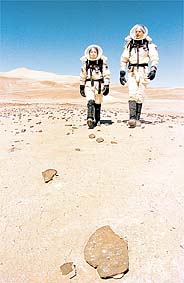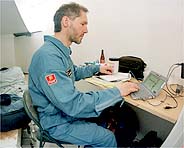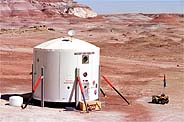BLAINE HARDEN . NY Times . 23 march 2002
 MARTIAN GOTHIC Tiffany Vora and Jonathon Dory are part of a Utah-bound group of 6 on an extended simulated mission to Mars. |
 Dr. Bjoern Grieger wrote last week that gusts of 60 miles an hour ripped open doors and windows in the module, on a simulated mission to Mars. |
 This module in Utah, occupied by six people, is designed to teach users to work together in a Mars-like site. |
HANKSVILLE, Utah, March 20 — In the red-rock desert west of this lonely little town, six seriously smart people are living in something that looks like a sawed-off corn silo and smells of their unwashed socks.
They have come to a fine spot for unorthodox behavior. A Mormon named Ebenezer Hanks came here in the 1880's to practice polygamy and nobody bothered him. The six recent pilgrims are practicing something even stranger and more isolating — living on Mars.
They go outside in white canvas space suits trimmed in duct tape. Their helmets are made from plastic light fixtures and white bullet-shaped trash-can lids. In their habitation module (the thing that looks like a silo), they sit with their laptops late into the cold desert night, typing up reports of simulated Mars disasters.
"Wind blows off the roof hatch," Dr. Bjoern Grieger, mission commander and an astrophysicist at the Max Planck Institute for Aeronautics in Germany, wrote in his log last week after 60-mile-an-hour gusts ripped open doors and windows in the module, exposing its inhabitants to the elements.
"Fortunately," Dr. Grieger wrote, "even high wind speeds would not do much damage on Mars, as the air density is much lower than on Earth. Otherwise, we had to consider ourselves dead now."
The not-so-deadly pretense of living on Mars while hanging out in a tall tin can in southern Utah is the latest wrinkle in a private plan to persuade the federal government to send humans to Mars sooner and for less money than envisioned by the National Aeronautics and Space Administration.
The Mars Society — a group of about 5,000 dues-paying Mars enthusiasts from 29 countries, many of whom are space scientists and some of whom work in senior positions at NASA — wants to send men and women to Mars within the next decade, at a cost of $10 billion, far below previous estimates by the space agency.
NASA has said it will not even contemplate a manned Mars mission until after 2020, when an unmanned spacecraft is scheduled to make a round trip to the planet. While the Mars Society concedes that a mission will be difficult to pull off without federal help, it argues that there is important publicity to be won and practical knowledge to be gathered when scientists seriously pretend they are working on a planet that at its nearest is 37 million miles from Earth.
The mantra of the Mars Society is "travel light and live off the land." Its primary scheme for slashing the cost and complexity of a Mars mission is to manufacture rocket fuel once on the planet. Martian air, which is mostly carbon dioxide, would be mixed with hydrogen to make fuel for the journey home.
"The people who are interested in going to Mars have the money to pay for it, provided they could be rallied," Dr. Robert Zubrin, an astronautical engineer and the founder of the Mars Society, said by telephone from his Denver office. "To that end, we decided we had to start small."
The modest module is part of Dr. Zubrin's master plan to rally support. Built with about $1 million in private donations to the society, it is the second of four planned stations (one opened in the Arctic in 2000) designed to teach biologists, geologists, engineers and physicists how to work together in a Mars-like site without driving each other crazy.
The module's parking space is in a barren corner of the West that bears an astonishing resemblance to actual pictures of Mars that have been transmitted back to Earth by various unmanned space agency.
The site should look authentic. It was found by Hollywood location scouts working for James Cameron, the film director of "Titanic." He is a Mars buff and has considered making a movie about the planet.
Mr. Cameron tipped off Dr. Zubrin, who moved the module in over the winter and opened it on Feb. 7 as the Mars Desert Research Station.
"The look of the place is very important from a p.r. point of view," said Dr. Grieger, commander of the third rotation of scientists to spend two weeks in the station.
That outer-spacey look has already lured American, German and British television news crews to Hanksville, and more are on the way. The six scientists now aboard the research station said that perhaps their most important duty was to be nice and photogenic. That is the most cost-effective way, they agreed, to create a groundswell of support for sending human beings to Mars.
They also agreed that, at the moment, no such groundswell exists.
"Kids these days, they have never seen a moon walk," said Nell Beadle, 36, the second-in-command aboard the station and a marine geologist who works for a Seattle company that maps the ocean floor. "It is kind of sad. They don't even see manned interplanetary travel in the realm of possibility."
Like her colleagues in the station, Ms. Beadle cannot remember a time when she was not a space geek who desperately wanted to go to Mars.
Ms. Beadle bought her first telescope at age 9, taught herself celestial navigation when she was 10 and completed a science fair project on Mars geology at 14. Sybil Sharvelle, a University of Colorado water-resource engineer who specializes in space station water supply systems, was in fifth grade when she bought NASA's Shuttle Operators Manual. Even now, at the age of 26, she has a habit of beginning dinner-party stories by saying, "When I was at space camp. . . ."
Erik Carlstrom, 25, another geologist on the module, saved up $865 as a teenager to go to space camp but ending up squandering it on violin.
Living in simulated Mars demands geeky enthusiasm. The module's "staterooms" are cramped windowless closets (except for that of the commander, who has a cramped closet with a window). Showers are available every four days. When the wind blows a certain way, the smell of the module's compost toilet insinuates itself into the upstairs room where everyone cooks, eats and writes reports. Earthly meals are prepared on a hot plate.
Although they are obsessed with space, members of the crew are realistic about their chances of actually getting into orbit. Ms. Sharvelle, for instance, is too short, at 5 foot 3, to qualify as an astronaut under the space agency's standards. Jonathon Dory, 26, the 6 foot 7 fix-it man on the module and a contract engineer at the Johnson Space Center in Houston, is too tall. The commander, Dr. Grieger, the only non-American aboard, has a stomach problem that would disqualify him.
"When I had my chance to simulate weightlessness, I completely filled my barf bag," said Dr. Grieger, who, besides playing astronaut here, has trained as an astronaut in Star City, the Russian space center.
This decidedly earthbound station, then, is as close to interplanetary travel as its temporary crew is likely to get. So, they make the most of it. Today, for example, they jumped into their canvas spacesuits for three walkabouts in the only Mars they will ever know.
The last walk took place at dusk. Tiffany Vora, 22, the crew's biologist and a doctoral student in molecular biology at Princeton, had seen on SpaceWeather.com that a comet might be visible in the early evening. (The module has a satellite Internet connection, but no television and no telephone.)
All six crew members tramped off to inspect southern Utah's ludicrously bright night sky. They stood side by side on a desert hill, threw back their heads and rejoiced in a cloudless display of stars, planets and a quarter-moon that cast razor-sharp shadows. Ms. Vora began to giggle.
It suddenly occurred to her, she said, that if she and her colleagues were to discover space aliens at this very moment in the desert, absolutely nobody on Earth would believe them. Who would trust six people who themselves were pretending to be on another planet?
Everyone exploded in laughter. Then they walked back to habitation module and cooked some supper.